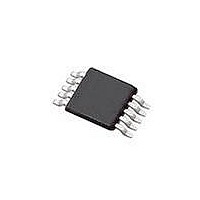SI4010-C2-GT Silicon Laboratories Inc, SI4010-C2-GT Datasheet - Page 112

SI4010-C2-GT
Manufacturer Part Number
SI4010-C2-GT
Description
IC TX 27-960MHZ FSK 3.6V 10MSOP
Manufacturer
Silicon Laboratories Inc
Series
EZRadio®r
Type
Crystalless SoC RF Transmitterr
Datasheet
1.SI4010-C2-GT.pdf
(156 pages)
Specifications of SI4010-C2-GT
Package / Case
10-MSOP
Mfg Application Notes
SI4010 Calculator Spreadsheet AppNote
Frequency
27MHz ~ 960MHz
Applications
Garage Openers, RKE, Security Alarms
Modulation Or Protocol
FSK, OOK
Data Rate - Maximum
100 kBaud
Power - Output
10dBm
Current - Transmitting
19.8mA
Data Interface
PCB, Surface Mount
Antenna Connector
PCB, Surface Mount
Memory Size
4kB RAM
Features
8051 MCU Core, Crystal-less Operation
Voltage - Supply
1.8 V ~ 3.6 V
Operating Temperature
-40°C ~ 85°C
Operating Frequency
27 MHz to 960 MHz
Maximum Operating Temperature
+ 85 C
Mounting Style
SMD/SMT
Operating Supply Voltage
1.8 V to 3.6 V
Supply Current
14.2 mA
Lead Free Status / RoHS Status
Lead free / RoHS Compliant
Lead Free Status / RoHS Status
Lead free / RoHS Compliant, Lead free / RoHS Compliant
Other names
336-1997-5
Available stocks
Company
Part Number
Manufacturer
Quantity
Price
Part Number:
SI4010-C2-GT
Manufacturer:
SILICON LABS/èٹ¯ç§‘
Quantity:
20 000
Company:
Part Number:
SI4010-C2-GTR
Manufacturer:
ST
Quantity:
1 000
Part Number:
SI4010-C2-GTR
Manufacturer:
SILICON LABS/èٹ¯ç§‘
Quantity:
20 000
Si4010-C2
30.2. Pullup Roff Option
There is an option to disable the weak pullup pad resistors. This feature is called Roff option. The Roff
option is controlled directly by the GPIO pads and persist when the chip is in the shutdown mode. Control
of the Roff control bit in the GPIO is described in section 30.4. Pullup Roff and Matrix Mode Option Con-
trol.
30.3. Matrix Mode Option
The target application of the device is the button intensive application, which samples button pushes at the
device inputs and acts accordingly.
Given the pin limited package, the target user application could use at most 5 buttons on a 10-pin package
and 9 buttons on 14-pin package. If the chip is in a shutdown mode, any button push (connection to any
GPIO to ground) wakes the chip up.
For the applications requiring more push button inputs than the available GPIO inputs, Matrix button mode
should be implemented on the device. This allows the buttons to be organized in 3x2 matrix for 10 pin
package or 3x6 matrix for the 14-pin package, allowing for up to 6 push buttons for 10 pin package and up
to 18 buttons on the 14-pin package. It is up to the firmware to scan the matrix sequentially to determine
the status of the buttons.
When the buttons are organized in Matrix mode any button push must wake the chip up from a shutdown
mode. Since the buttons are not connecting GPIO to ground, but connecting an input GPIO to some output
GPIO, the output GPIO must be connected to ground during the chip shutdown. That is achieved by setting
the Matrix option control bit in the GPIO latch. When that bit is set then the GPIO[3:1] are actively pulled to
ground when the chip is in the shutdown mode and digital logic has no power internally.
Note that to use the Matrix mode the Roff option must not be used. In other words, all the pullup resistors
must stay in place for all the GPIO. There should be values PORT_MATRIX=1 and PORT_ROFF=0
latched into GPIO options control latch.
When the Matrix mode is latched into the GPIO control latch the pullup resistors of the GPIO[3:1] are dis-
connected and the pull down transistor on those GPIOs is activated.
Important: Before invoking a Matrix mode the user is responsible for programming all GPIO[3:1] as
inputs. This is achieved by writing 1 to P0[3:1] and writing 0 to P0CON[3:1]. Only after that the Matrix
option can be invoked.
If the chip went to shutdown with Matrix option set, then it will be woken up by any button press of the but-
ton matrix. It is a responsibility of the user application which must turn the Matrix mode off before the soft-
ware can scan the button matrix for current button status. The button scanning is usually done scanning
the matrix driver pins GPIO[3:1] with one-cold pattern, applying sequential binary patterns GPIO[3:1]=110,
101, 011, and 111 using open drain configuration of the GPIO[3:1]. By collecting corresponding responses
on the GPIO[4,0] or GPIO[4,0,9:6], input GPIOs to the driving one-cold patterns firmware can determine
what buttons are currently pushed.
112
Rev. 1.0












